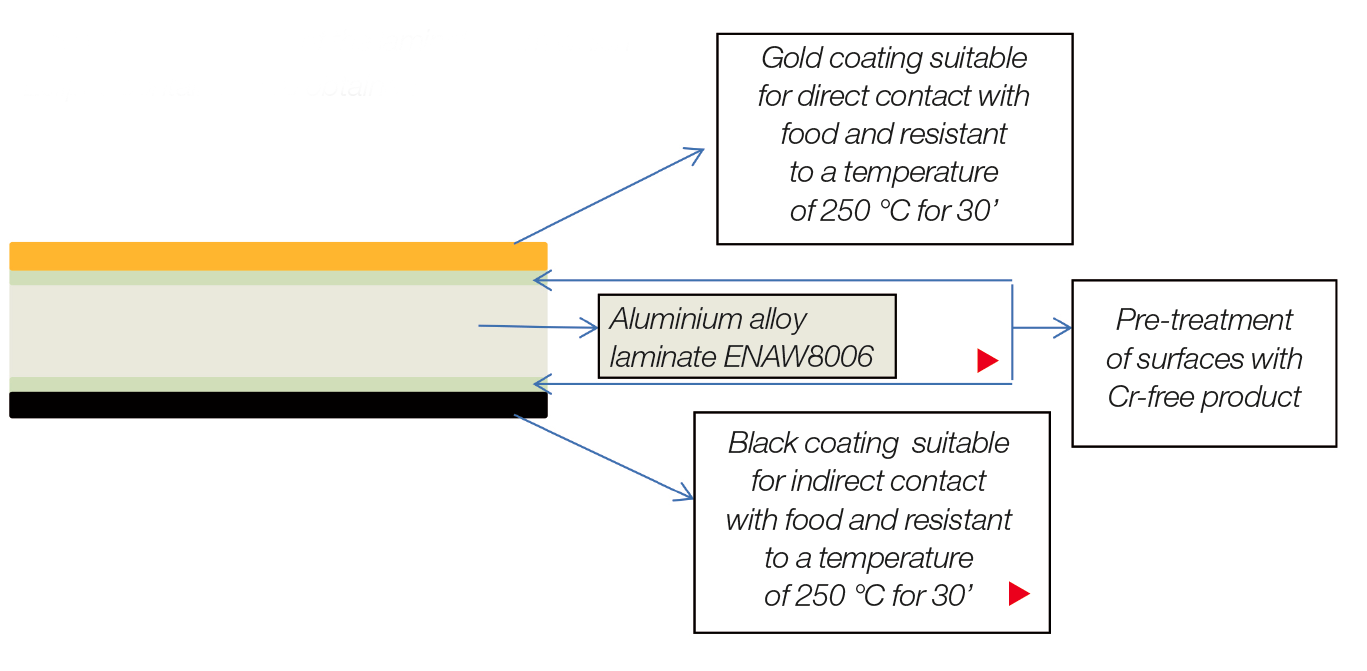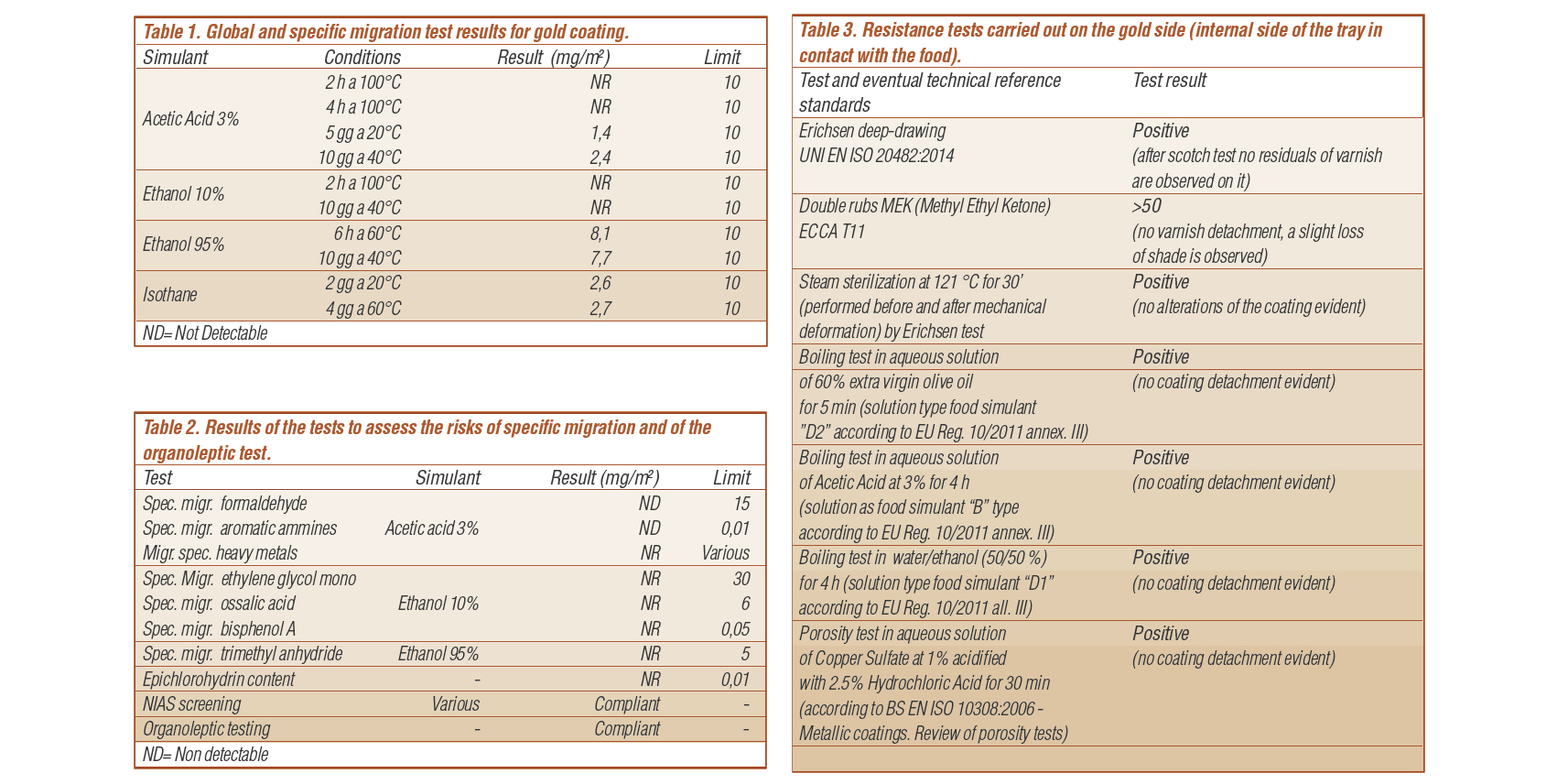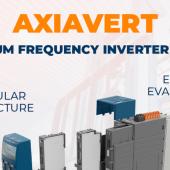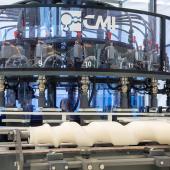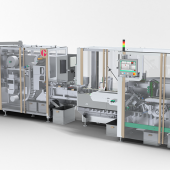Eclipse: luxury containers for food delivery
The phases of research that allowed Contital (Laminazione Sottile Group) to design and industrialize aluminum trays for gourmet take-away, in the name of food safety, functional elegance and easy recycling. C. Sinagra, A.W. Ipock, F. Bravaccino, F. Milanesi, M. Nicolais, P. Pollice
The development of containers for take-away food has gone hand in hand with the affirmation of food delivery companies, which have offered consumers the possibility of ordering and paying for the food they want online from their favorite restaurant, to receive it at their doorstep in a short time.
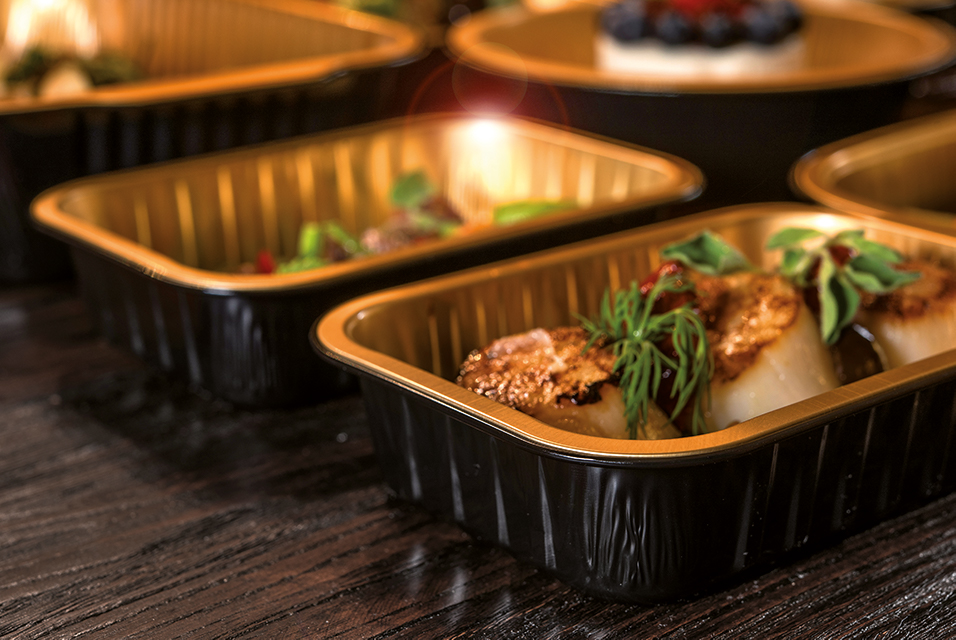
The epidemic of the Covid19 virus has given a sudden acceleration to the food delivery service in Italy as well. This is demonstrated by the estimates of the B2C eCommerce Observatory promoted by the School of Management of the Milan Polytechnic and the Italian Electronic Commerce Consortium Netcomm, which estimate for online food & grocery a value of 2.5 billion euros in 2020, with an increase of 55% - almost one billion euros in absolute value - compared to 2019.
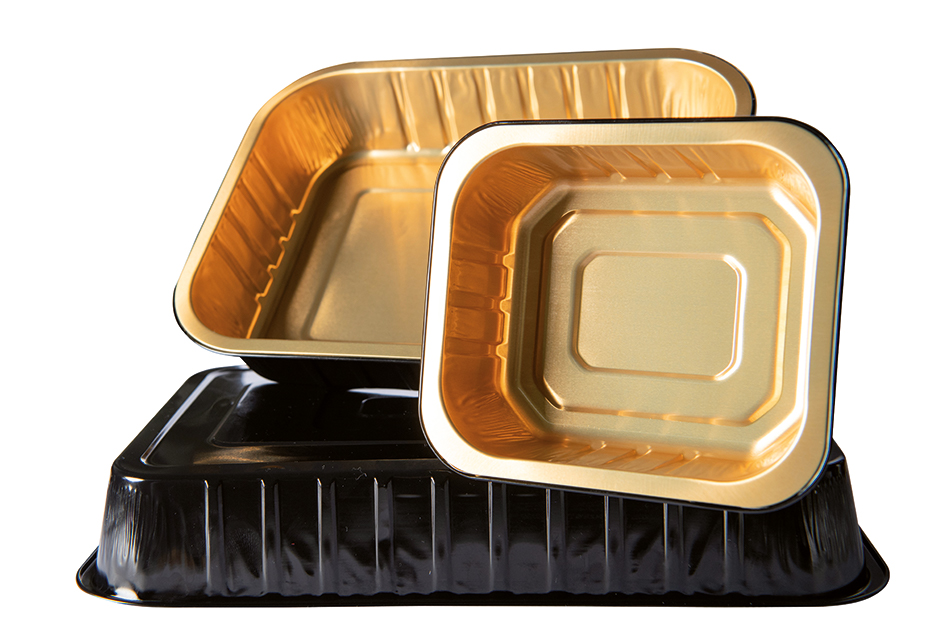
Eclipse, functional and sustainable: how and why
Many prestigious restaurateurs have also been involved in the take-away business: accustomed to serving dishes in their restaurants that are not only tasty but also aesthetically pleasing, they have, however, come across packaging solutions that are sometimes questionable... and chefs know how much the success of a dish depends on careful presentation.
It was from this premise that Contital (part of the Laminazione Sottile Group) came up with the idea of creating a “luxury” line of aluminium trays press-moulded with smoothwall technology. This is how Eclipse was born, a range of functional yet elegant containers, ready to enhance the culinary preparations that arrive directly at home, where food safety and aesthetics are the main features.
It should be emphasized that the trays, already produced with over 30% recycled aluminum, are in turn totally recyclable, eliminating the need for washing after use, thus avoiding the waste of precious water: in fact, it is enough to empty them of food residues and throw them in the segregated collection, to be then recovered and sent for recycling by remelting (at 750 °C any organic residue will be transformed into carbon, an element that, unlike steel, has no affinity with aluminum).
Once remelted, the metal will offer the same performance as primary aluminum, but with energy savings of 95%: 0.4 KWh per kg of secondary Al against 16 KWh per kg of primary Al and CO2 production 17 times lower (0.41 kg CO2 eq. per kg of secondary Al against 7.14 kg CO2 eq. per kg of primary Al).
In other words, with Eclipse, aesthetics meets hygiene, functionality and sustainability (Figure 1).
Food safety: total and specific migration tests for the gold coating
With a view to marketing Eclipse containers, especially in the take-away sector, Contital had a screening carried out by an accredited laboratory to verify their conformity to contact with foodstuff.
In the choice of the test conditions to be carried out in order to assess the correct use for the hypothetical destination of use, both the consumption of a hot meal and possible conservation for prolonged periods were considered.
Test conditions. The laboratory therefore referred to the draft version of the Guidelines produced by the JRC on testing methods, which the laboratories adopt, for example, to define the conditions related to the testing of screening/simulant substitutes.
For “testing conditions”, the “Testing conditions for kitchenware articles in contact with foodstuffs - Part 1: Plastics The EURL-FCM harmonized approach series” was published in September 2019 by the JRC.
In that document, the proposed testing conditions for containers to be subjected to heating or cooking vary from 2 to 4h at 100 °C.
Wanting to also cover storage for a few days, the laboratory opted to perform the complete a test plan using the OM2 10-day condition at 40 °C, a condition that covers any prolonged storage at room temperature or below, including when packed under hot filling and/or heating conditions up to a temperature T, where 70 °C ≤ T ≤ 100 °C for t = 120/2^ [(T-70)/10) minutes at most.
In other words, with a 10-day test at 40 °C, heating up to 70 °C for a duration of up to 2 hours or heating up to 100 °C for a duration of up to 15 minutes is covered.
Consequently, the complete test plan, including global and specific migrations, was performed referring to the 10-day contact conditions at 40 °C.
Screening simulants and tests performed. Regarding the selected simulants, the laboratory opted for the use of 10% ethanol, 3% acetic acid, and the use of screening simulants/oil substitutes such as 95% ethanol and isooctane. The operating condition of 10 days at 40 °C, however, was remodeled.
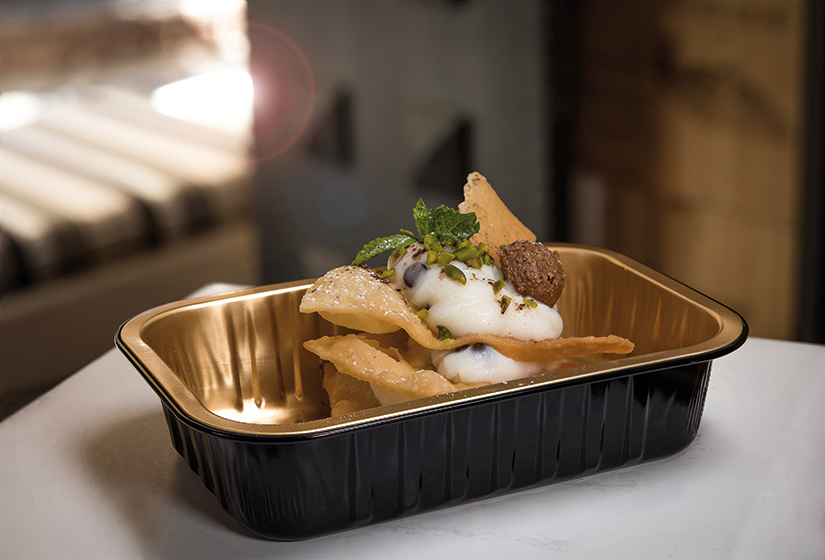
Screening simulants and tests performed. Regarding the selected simulants, the laboratory opted for the use of 10% ethanol, 3% acetic acid, and the use of screening simulants/oil substitutes such as 95% ethanol and isooctane.
The operating condition of 10 days at 40 °C, however, was remodeled according to the type of simulant. In the light of the analytical experience gained on matrices identical to the one under study, the laboratory performed for 3% acetic acid a 5-day contact at 20 °C by inserting the simulant heated to 70 °C. In this way, after heating conditions, a preservation of the food contained in the container for a few days (compatible with any microbial development) under refrigeration conditions has been assumed.
In consideration also of the use for cooking purposes, a test plan related to the global migrations at the conditions of 2h at 100 °C and 4h, which correspond to cooking times up to 1 hour and temperatures of about 200 °C was agreed upon.
To recapitulate, the global migration tests performed and their results are listed in Table 1.
In addition to the global migration tests, the following were performed:
• specific migration testing, following the “worst case” strategy;
• NIAS (unintentionally added substances) risk assessment, using HS-GCMS, GC-MS, and LC Q-TOF techniques, in order to identify volatile, semi-volatile, and non-volatile, polar and non-polar compounds;
• specific migration test of aromatic amines and heavy metals in 3% acetic acid;
• specific migration test of 2,2-bis(4-hydroxyphenyl)propane (Bisphenol A) in 10% ethanol;
• epichlorohydrin content;
• organoleptic test.
The results of the above tests are shown in Table 2.
During the tests, the materials proved to be inert, showing that they did not transfer components in such quantities as to constitute a danger to human health, bring about an unacceptable change in the composition of foodstuffs or bring about a deterioration in their organoleptic characteristics, thus respecting the key principles defined by the applicable Framework Regulations and Specific Regulations. On the basis of the tests carried out, therefore, the objects can be reasonably considered suitable for heating and short cooking and for prolonged contact with foodstuffs, and free from risks to human health as provided for in art. 3 of Regulation 1935/2004/EC (Table 3).
Electrochemical tests carried out on the gold side (internal side in contact with food). In order to verify the resistance to corrosion offered by the gold polymer coating, electrochemical impedance spectroscopy tests were carried out (figures 2 - 5) in aerated aqueous solution of NaCl 3.5% wt and Na2SO4 0.3M acidified to pH 4 with H2SO4 for up to 7 days (EN ISO 16773, Paints and varnishes - Electrochemical impedance spectroscopy (EIS) on high-impedance coated specimens).
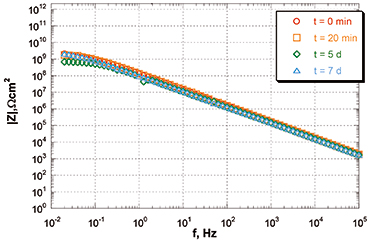
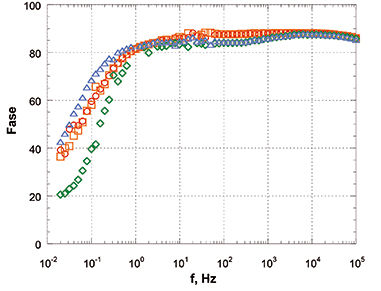
Figure 2
Electrochemical Impedance Spectroscopy modulus on Eclipse tray gold epoxy inner side on AA8006 w/ GD802 no-rinse in aerated acqueous solution of NaCl at 3,5%wt.
Figure 3
Phase angle measurement on Eclipse tray gold epoxy inner side on AA8006 w/ GD802 no-rinse in aerated acqueous solution of of NaCl at 3,5%wt.
Impedance tests show a good resistance to corrosion both in aerated aqueous saline solution of neutral 3.5%wt Sodium Chloride and in aerated acidified solution of 0.3M Na2SO4 where it is noted, after 5 days, a slight decrease of the impedance modulus |Z! that remains at more than acceptable values of 108Ωcm2 at frequency 0.02Hz.
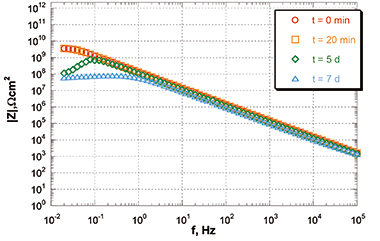
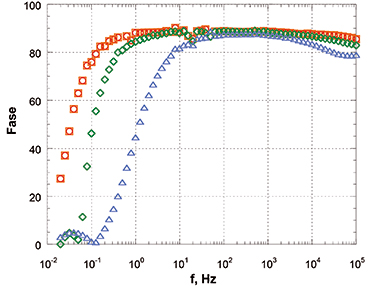
Figura 4
Electrochemical Impedance Spectroscopy modulus on Eclipse tray gold epoxy inner side on AA8006 w/ GD802 no-rinse in aerated acqueous solution of Na2SO4 0.3M at pH 4.
Figura 5
Phase angle measurement on Eclipse tray gold epoxy inner side on AA8006 w/ GD802 no-rinse in aerated acqueous solution of Na2SO40.3M at pH 4.
In conclusion
A beautiful, luxurious and attractive solution for food delivery: Contital’s Eclipse line has achieved the aesthetic objective of being an elegant packaging capable of enhancing the food contained, both by preserving it during transport and by exalting it when served. The product design features a technical-scientific approach, so as to guarantee the maximum safety in food contact and ensure its functionality until the end of its lifecycle when, sorted in the segregated collection like any beverage can, it is recovered and, by means of re-melting, becomes a new object in an endless recovery cycle.
A reminder that in Italy, thanks to the work of CIAL (Consorzio Nazionale Imballaggi Alluminio - National Consortium for Aluminium Packaging), more than 80% of aluminium packaging is recovered, demonstrating the real sustainability of this metal. This should be duly stated, and is fully in line with the European “Green Deal”, i.e. the roadmap that the European Community is drawing up to make the EU economy sustainable, turning climate issues and environmental challenges into opportunities in all policy areas and making the transition fair and inclusive for all.
Bibliography
[1] C. Sinagra - “State-of-the-art laminates for trays”, ItaliaImballaggio, no. 10, October 2009.
[2] C. Sinagra, I. Treaccani, P. Pollice - “Quando l’estetica si fa forma”, ItaliaImballaggio n.6, June 2008.
[3] C. Sinagra - “Producing laminates: focus on hygienic aspects. Basic rules for the moulding of trays in contact with foodstuffs” - A&L (EDIMET) n. 3/2009 from page 75 to page 80.
[4] A. Amitrano, C. Salerno, C. Sinagra - “Electrochemical techniques for the evaluation of corrosion resistance of bare and coated aluminum alloy laminates”, Verniciatura Industriale n.534, 10-2012 pp. 640-653.
[5] A. Amitrano, C. Salerno, C. Sinagra - “Cr-free surface pretreatments for aluminum and its alloys laminates” - Verniciatura Industriale no. 548, pp. 768-780.
[6] C. Sinagra, C. Bitonto, A. Bossio, T. Monetta, F. Bellucci - “No rinse Cr free surface treatments on Aluminium foil for flexible packaging: opportunities, advantages and electrochemical measurement for performance evaluation” - API2015 - Advances in the Packaging Industry, 1st International Congress, November 19 and 20, 2015, Naples, Italy, pp. 123-129.
Authors
C. Sinagra, A.W. Ipock, F. Bravaccino, R&D Dpt Laminazione Sottile Group;
F. Milanesi, Marketing and Communication Laminazione Sottile Group;
M. Nicolais, Contital Quality Manager;
P. Pollice, Contital Sales Director.


